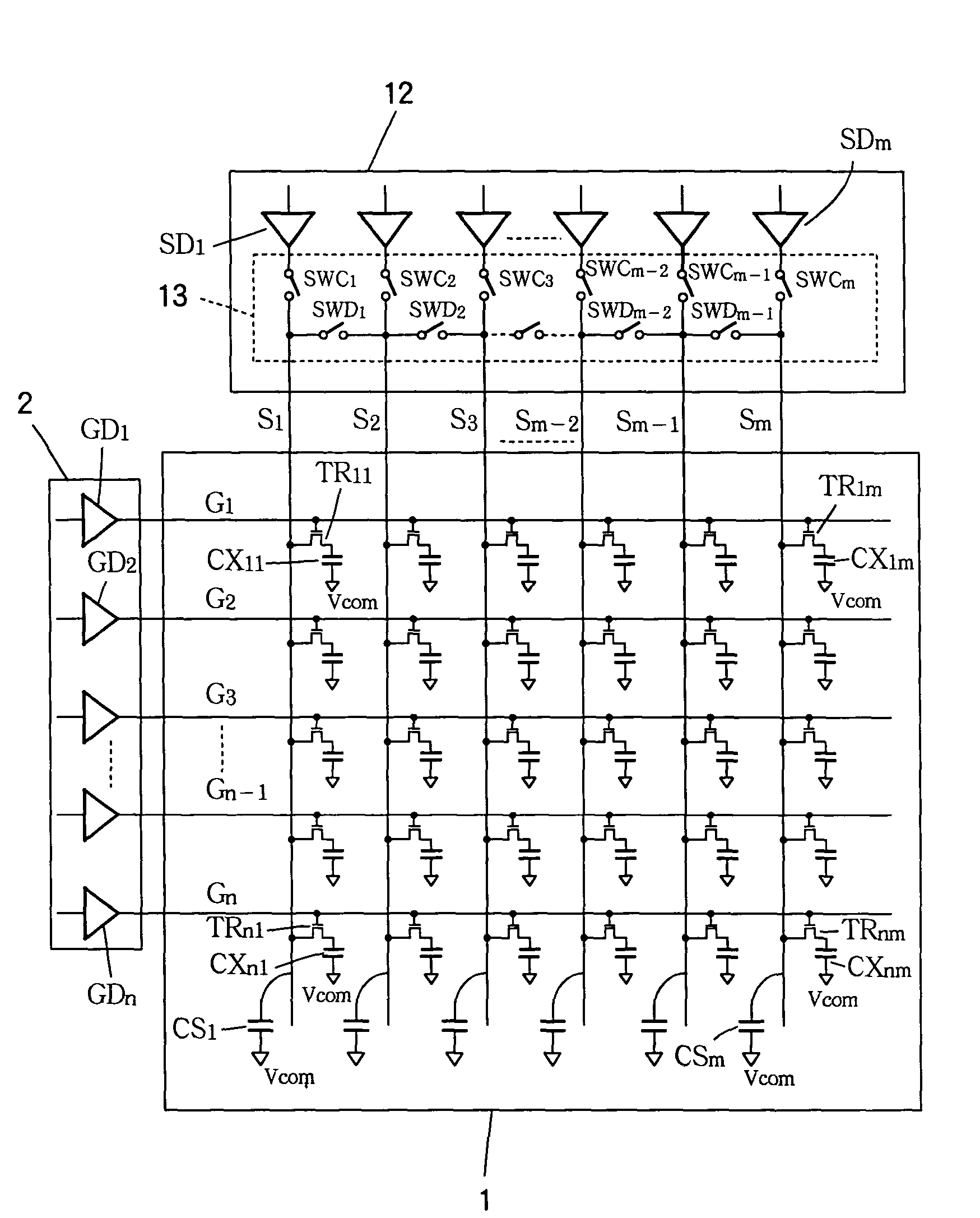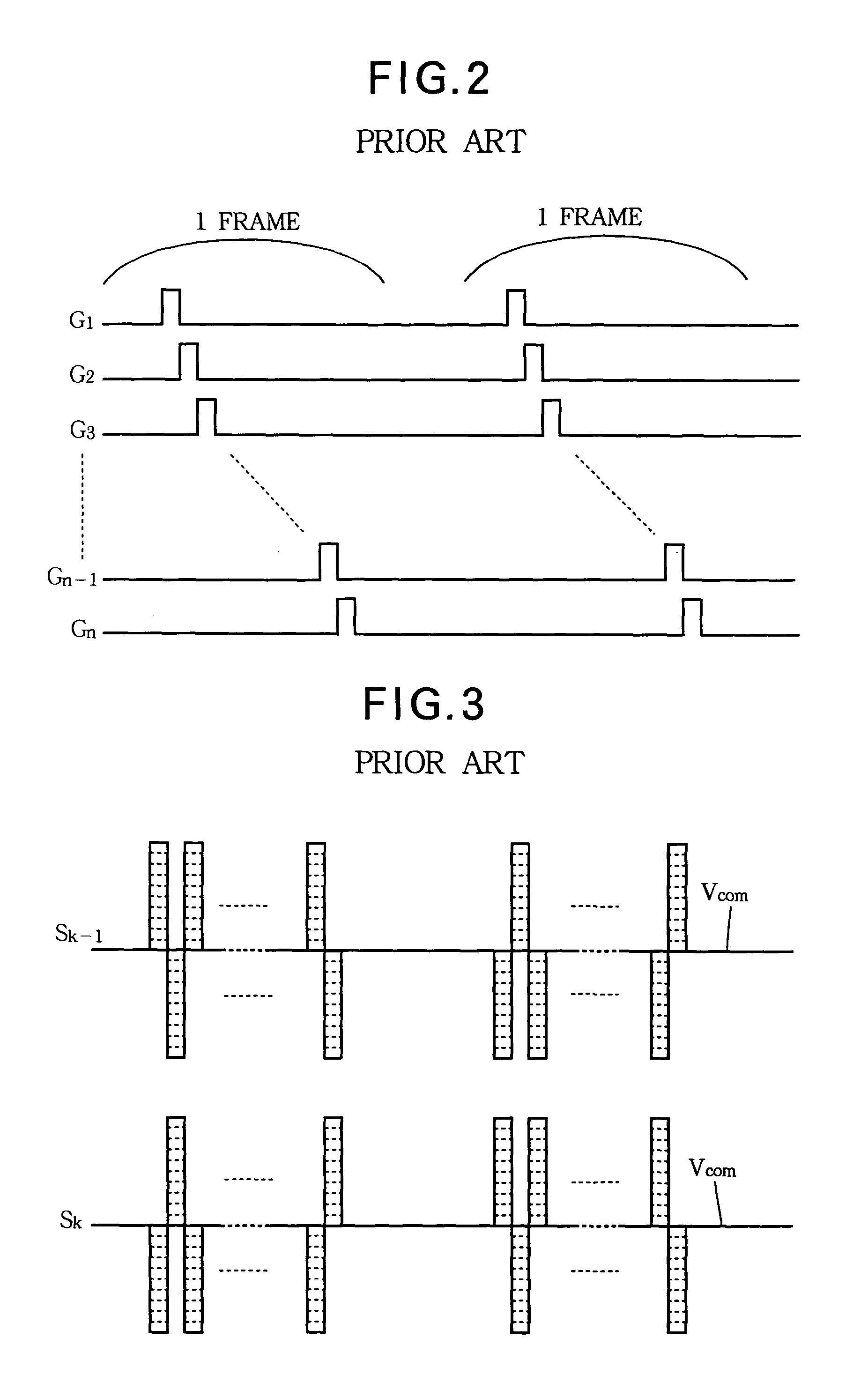Liquid-crystal display driving circuit and method
a liquid crystal display and driving circuit technology, applied in the direction of electric digital data processing, instruments, computing, etc., can solve the problems of large source-line driving circuits, increased current consumption, and increased time needed to charge the parasitic capacitance of source lines, so as to reduce electrical noise, reduce current consumption, and reduce the effect of driving capability
- Summary
- Abstract
- Description
- Claims
- Application Information
AI Technical Summary
Benefits of technology
Problems solved by technology
Method used
Image
Examples
first embodiment
[0047]FIG. 4 shows the invention. The LCD panel 1 and gate-line driving circuit 2 are similar to the conventional elements shown in FIG. 1.
[0048]The source-line driving circuit 10 in the first embodiment has a switching circuit 11 comprising switches SWA1 to SWAm and SWB1 to SWBm. Switch SWAj couples source line Sj to source driver SDj (j=1, . . . , m), while switch SWBj couples source line Sj to a common electrode (not visible) held at the potential Vcom of the common electrode of the liquid-crystal capacitors. Switches SWAj and SWBj comprise, for example, field-effect transistors. This type of switching circuit 11 can easily be added to existing source-line driving circuit designs.
[0049]The switches SWAj and SWBj are controlled in synchronization with the gate drivers GD1 to GDn. Normally, switches SWAj are all closed, and switches SWBj are all open. At times of transition of the gate lines G1 to Gn between the high and low levels, however, for a brief interval switches SWAj are o...
second embodiment
[0056]FIG. 5 shows the invention. The LCD panel 1 and gate-line driving circuit 2 are similar to the conventional elements in FIG. 1.
[0057]The source-line driving circuit 12 in the second embodiment has a switching circuit 13 comprising switches SWC1 to SWCm and SWD1 to SWDm−1. Switch SWCj couples source line Sj to source driver SDj (j=1, . . . , m), while switch SWDj couples source line Sj to source line Sj+1 (j=1, . . . , m−1). Switches SWCj and SWDj comprise, for example, field-effect transistors, and can easily be added to existing source-line driving circuit designs.
[0058]The control of switches SWCj and SWDj is analogous to the control of switches SWAj and SWBj in the first embodiment. Normally, switches SWCj are all closed, and switches SWDj are all open. At each transition of any of the gate lines G1 to Gn between the high and low levels, for a brief interval switches SWCj are opened, and switches SWDj are closed, thereby disconnecting the source lines from the source driver...
third embodiment
[0060]FIG. 6 shows the invention. The LCD panel 1 and gate-line driving circuit 2 are similar to the conventional elements in FIG. 1.
[0061]The source-line driving circuit 14 in the third embodiment has a switching circuit 15 comprising switches SWC1, SWC2, . . . , SWCm and SWD1, SWD3, . . . , SWDm−1. Switching circuit 15 is obtained from the switching circuit 13 of the second embodiment by removing the even-numbered switches SWD2, SWD4, . . . , SWDm−2 that short-circuit adjacent source lines.
[0062]The third embodiment operates in the same way as the second embodiment, but when switches SWChd j (j=1, 2, . . . , m) are opened and switches SWDj (j=1, 3, . . . , m−1) are closed, each source line is short-circuited to just one adjacent source line. Since adjacent source lines are driven to potentials on opposite sides of a center potential approximately equal to Vcom, each short-circuited pair of source lines is brought to a potential in the general vicinity of Vcom.
[0063]The third embod...
PUM
| Property | Measurement | Unit |
|---|---|---|
| capacitance | aaaaa | aaaaa |
| capacitance | aaaaa | aaaaa |
| speed | aaaaa | aaaaa |
Abstract
Description
Claims
Application Information
 Login to View More
Login to View More - R&D
- Intellectual Property
- Life Sciences
- Materials
- Tech Scout
- Unparalleled Data Quality
- Higher Quality Content
- 60% Fewer Hallucinations
Browse by: Latest US Patents, China's latest patents, Technical Efficacy Thesaurus, Application Domain, Technology Topic, Popular Technical Reports.
© 2025 PatSnap. All rights reserved.Legal|Privacy policy|Modern Slavery Act Transparency Statement|Sitemap|About US| Contact US: help@patsnap.com



